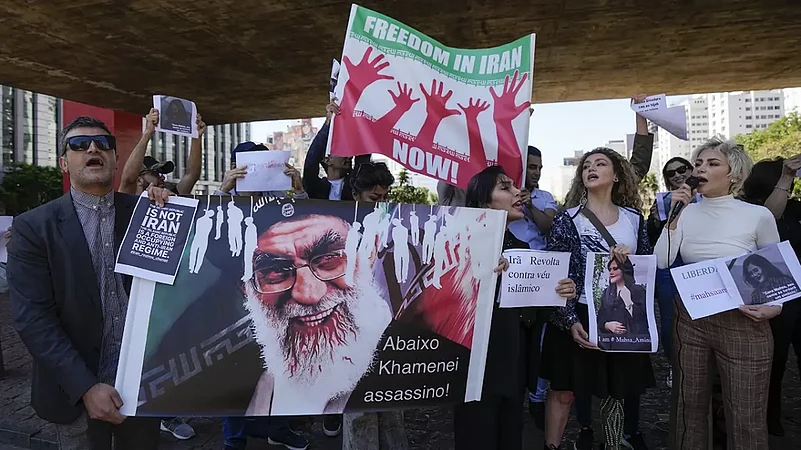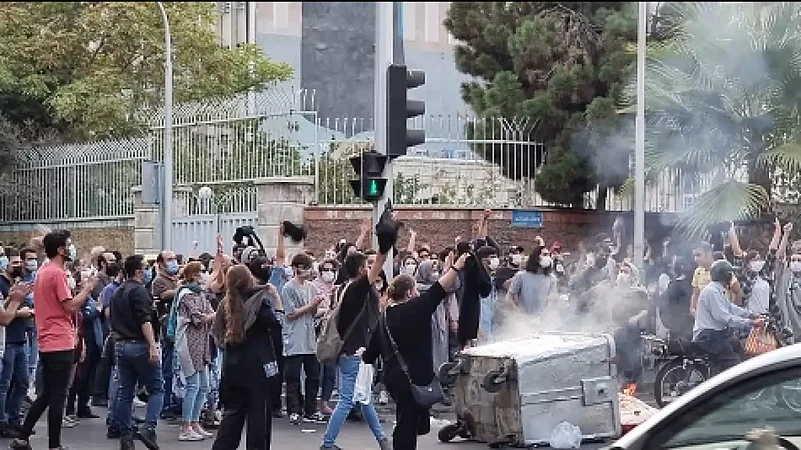There is an incident every few years that makes countless people unconnected among themselves rally for a cause.
Sometimes, it’s a woman gangraped in a moving bus in Delhi. Sometimes, it’s a Black American killed by a police officer. In the latest case, it’s the death of a 22-year-old woman in Iran.
Mahsa Amini was detained by Iran’s ‘morality police’ for violating the country’s dress code. Women are required by law in Iran to wear a hijab —a head covering— among other requirements, such as to wear loose-fitting clothes and not wear form-fitting or revealing clothing. She was allegedly beaten in the morality police’s custody. She died later in a hospital.
In a country where women are detained for showing their hair even partially, the sight of hundreds of women waving their hijabs in the air and burning them and cutting their bare hair in public would be unimaginable. Yet such acts of defiance have been regular across Iran for weeks since Amini’s death.
The protesters —overwhelmingly women— are not merely calling out police brutality or expressing anger against Amini’s custodial death. They are also challenging the Iranian state and its inability to fulfil its own promises and people’s aspirations.

While the immediate trigger for the nationwide protests was Amini’s death, the protests are the latest in the long line of protests and combine several factors ranging from disgruntlement over economic difficulties to anger against the state apparatus that could not keep up with its own promises.
Hijab: From symbol of defiance to state imposition
The ongoing protests in Iran against mandatory wearing of hijab are likely to give an impression that women overwhelmingly oppose hijab in the country. It would also appear that hijab is a symbol of a state rooted in Islamic orthodoxy. While this would be partially true, it is far from truth. The truth is much more nuanced.
Hijab became mandatory in Iran after the Islamic Revolution of 1979 which brought Islamic clergy to power after overthrowing the liberal, pro-West monarchy.
In decades before 1979, women were free to dress as per their choice and photographs available from the period show women in skirts, dresses, and swimsuits.
In 1935, King Reza Shah Pehlavi banned the public wearing of hijab. His son Mohammed Reza Pehlavi, who succeeded him in 1941, turned the ban into a choice. Women were free to wear or not wear hijab as per their choice. However, through the liberal reign of Pehlavi, several women took to hijab as a political symbol.
Pehlavi was supported by the West and was known for his lavish lifestyle. Section of Iranian population as well as the clergy opposed his rule. Wearing hijab in public became a symbol of defiance and protest against the monarchy. While the monarchy was overthrown in 1979, the movement had been ongoing for a long time and women actively participated in it and often wore hijab.
There is another oft-overlooked factor of hijab during the Pehlavi rule. During the years of absolute ban on hijab, several girls and women from orthodox families lost their access to schools, colleges, and public life in general because their families would not allow them outside without hijab.
Soon after the Islamic clergy came to power in 1979, hijab began to be enforced by the rulers on the women. From a symbol of defiance against the monarchy just days ago, hijab turned into a symbol of new Iranian state’s authority.
Women’s protests challenge Iranian state, Islamic Revolution
The present Iranian state is rooted in the Islamic Revolution of 1979. The Revolution against the Pehlavi monarchy promised social justice, greater freedoms, and independence from global power tussles.
Decades later, the chants of “Death to the Dictator” and jin-jiyan-azadi —women-life-freedom— throw a challenge in the face of the state and the Revolution itself as the two cannot be separated.
“Just like communism, a state was never the objective of the Revolution. The organs of the Iranian state serve the Revolution, not the other way around,” note Ali Ansari and Kasra Aarabi in a paper for Tony Blair Institue for Global Change.
The movement thus highlights the legitimacy crisis and erosion of popular support for the state along with a challenge to the brand of Islam —state religion— followed and enforced by the state, says Deepika Saraswat, an Associate Fellow at the West Asia Center at the Manohar Parrikar Institute for Defence Studies and Analyses (MP-IDSA).
She tells Outlook, “These young women while asserting their basic right of personal autonomy are in fact challenging the state religion whose interpretation and enforcement they perhaps see as being carried out in an authoritarian manner. Hence, the slogan ‘Death to the Dictator’.”
There is also a perception that is coming to the fore with the ongoing protests — the failure of the promises of the Revolution. Ali Fathollah-Nejad, an Iran expert, notes in an article for the Brookings Institute that while the Revolutionaries overthrew the monarchy, a new class of elites came up to replace the previous one instead of a wider systematic change.
“The class character of Iranian society has remained unchanged, with one ruling class replaced by another only with another social composition...In this process, modern Iran’s three dominant politico-ideological formations, or political cultures—namely nationalism, socialism, and Islamism—were narrowed to heavy emphasis on the latter [Islam], which managed to incorporate elements of the others,” notes Fathollah-Nejad.
Saraswat also notes that protesters are seeking promises made in the Revolution, such as freedom and greater rights.
“These protests intertwine with the broader demand of ‘freedom’ in the sense of individual political and cultural rights and openness, which was also a key promise of the Islamic Revolution that overthrew the Pehlavi monarchy. The popularity of slogan of jin-jiyan-azadi [women-life-freedom] would suggest that the current round of protests are better understood within the notion of civil rights movement,” says Saraswat.
The many factors of Iran protests
The ongoing movement in Iran is over “an entirely domestic issue” and there are several factors other than the intersection of women’s rights, politics, and religion at play here, says Arshi Khan, Professor of Political Science, Aligarh Muslim University (AMU).
Khan told Outlook, “There are several factors behind the making of these protests — the Shia factor, the Iran factor, the regional factor, and the Kurds factor. These factors mean that the protests have been blown out of proportion outside Iran.”
Explaining these factors, Khan says, “Iran is the only Shia country in the region with Sunni Saudi Arabia as its rival, so these are the Shia and regional factors. It’s also considered to be the only security threat in the region by Israel and Saudi Arabia, so that’s the Iran factor. The woman who tragically died was a Kurd, so that’s another factor.”
Kurds are spread across Iran, Iraq, Syria, and Turkey, and are allied with the United States, the principal rival of Iran. People in these countries have also held demonstrations in support of women in Iran.
When asked if the ongoing protests are a rights movement, a political protest, or a call for religious reforms — or a merger of all three, Khan says it’s certainly a political movement that serves a lot of external interests as well. He says the movement is another way in which the legitimacy of Iranian state would be put into question and which would benefit the actors hostile to Iran, such as the United States.
“There are continuous efforts to malign the identity of Iran and the ongoing protests are a perfect opportunity to inflict a setback to Iranian state’s legitimacy. Incidents like these happen in other countries too, even in democracies like India and the United States, but they are not blown out of proportion. So a pretext is being created with these protests,” says Khan, noting that Iran is the only country in the region that has avoided a regime change like in Iraq, Egypt, or Libya, or a mass movement for such a change such as in Syria.
While Khan says that questionable legitimacy of the state is expected to be an outcome of such protests, IDSA’s Saraswat says it is a reason driving these protests.
“These protests also expose a crisis of legitimacy and erosion of popular support for the Islamic Republic,” says Saraswat.
Failure of Iranian moderates, West’s misplaced solidarity
The West led by the United States has expressed solidarity with the women protesters in Iran. Within days of Amini’s death, the US government imposed sanctions on Iran’s morality police and a number of senior officials as a punitive measure.
Prominent personalities such as actors and activists have also come out in support of the protesters, with some cutting their hair publicly in an act of solidarity with the women in Iran, who are cutting their hair in public and waving hijabs in the air in protest.

However, such an attitude of the West runs afoul of their policy and risks being counter-productive.
Saraswat says years of US policies have weakened prospects of reforms in Iran and have strengthened orthodox factions.
“The current protests in a way underscore the failure of reformists and moderates, who had been enthusiastically voted to power by youth with a mandate for liberalisation both at home and also in foreign policy. However, as a result of the institutional dominance of the unelected conservative institutions, such as the office of the Supreme Leader and the Guardian Council, the reformist administration of Mohammad Khatami (1997-2003) and later the moderate Hassan Rouhani government (2013-21) could not bring any meaningful change,” says Saraswat, adding that the hostility with the United States also has a role in this.
She says, “Both reformists and moderates became victims of Washington’s unremitting hostility towards the Islamic Republic of Iran, which undermined the reformists and moderates as ‘weak’ and strengthened the hardliner and principalist politics of resistance. These protests therefore are also a form of dissent against an unresponsive state.”
The solidarity by the West and the proactive punitive measures like sanctions by the governments also risk protesters being labelled as Western agents, allowing for an easier suppression as the government could then claim that their crackdown is on a West-sponsored movement and thus legitimate.
“In a way, it undermines the agency of the protesting youth and the key issues driving the protests. The US support also undermines the movement by playing into Iranian government's attempts at polarising the popular opinion,” says Saraswat.
The future of the protests
When asked about the future of Iranian protests, AMU’s Khan says it’s not the first time such protests have happened and it will likely happen in the future too.
“No state will tolerate violent protests. The supremacy of the state cannot be challenged. The modern states believe in the principle of dual morality, which says that the crime of an individual will be judged differently than the crime of the state,” says Khan.
He adds that while authorities are likely to punish those behind Amini’s death, it’s not expected the state would give a nod to the challenge by protests. Much more than a domestic protest is at stake here.
“Every time the Iranian state gets challenged, the rivals of Iran are benefitted,” says Khan.
















